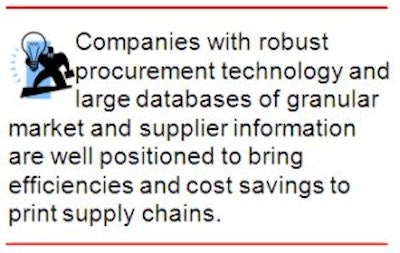
Print, as most know it, has forever changed thanks to the Internet, social media and e-book devices such as Apple's iPad and Amazon's Kindle. And, this is just the beginning of a new era of mass communication that is changing how we access information. It's a cultural change as much as a technological change.
"Of course, saying print is disappearing as an industry is an overstatement," says William Gindlesperger, chairman and chief executive officer of e-LYNXX Corporation, a leading North American print procurement firm based in Chambersburg. "Print, however, is changing, and changing dramatically."
Gindlesperger notes that printers are struggling. Predictions are that about 9,500 printers in the United States will disappear by 2020. That would leave about 27,000 printers down from a high just a few years ago of 36,500, according to Printing Industry of America (PIA) numbers.
The ranks of print buyers also are thinning. There are about 23,000 corporate print buyers today and several times that number of buyers that purchase $5,000 or less a year of print — direct mail, commercial print, marketing materials, documents, labels, customized packaging, CR ROMs, premiums, logo apparel or anything that requires the reproduction of an image on a substrate (paper, plastic, textiles, magnetic media, etc.).
While there are fewer printers and fewer print buyers, according to Gartner Research, print procurement continues to grow as an outsourced business process within Corporate America. New procurement methods and technology are why. Companies with robust procurement technology and large databases of granular market and supplier information are well positioned to bring efficiencies and cost savings to print supply chains, according to Gartner.
This observation reflects the changing needs of an industry that is modernizing and becoming more sophisticated. Gone are the days when the buyer could just depend on a few printers from which bids could be requested in hopes that one would be reasonable. Many of those printers are no longer in business. It is incumbent upon the buyer today to use the latest in procurement advances to broaden its supplier base and strengthen its process for procuring print.
"New procurement methodology makes it possible to match print buyers with printers of their choosing anywhere in the United States, instantaneously," says Gindleseperger. "This is done automatically on a job-by-job basis. Because each of the printers in the buyer's database is thoroughly vetted, the buyer knows that regardless of any other factors, the printer will deliver quality products on time. The buyer also knows that suppliers in its database will be the same dependable group considered for all of its work, and that the computer will only invite bids from suppliers capable of doing a particular type of job."
Because printers are anxious for work, the new process encourages low bidding to fill downtime — typically times that printers hold in reserve for key customers to run unscheduled projects. With 30 percent of their production capacity free at any given time (based on the national average), printers usually welcome the opportunity for work that will fill work-load gaps.
Lowering pricing to fill production schedules is a common practice in the industry, and one that makes sense, explains Gindlesperger. Doing work for a lower fee is better than not having any work at all. Staff and equipment are not idled. Used as a strategy consistently, this approach can increase a printer's bottom line annual profitability by about 10 percent.
By using a system that identifies low bids from qualified suppliers, the print buyer benefits by reducing its cost for procured print by 25 percent to 50 percent. That is just one benefit. The system also improves efficiencies, controls, reporting and communications without e-mails. Full transparency occurs because every detail of the process, from start to finish, is displayed and then captured on the web-based communications and workflow system. It becomes a valuable archival reference for future projects.
This new approach is doing for print buyers and printers what the iPad and Kindle are doing for publishers and consumers, says Gindlesperger. It uses advances in technology and methodology to give print buyers instantaneous choices, greater options, more predictable results, enhanced quality, clearer communications and better use of resources. It provides the printer with a dependable source for winning work through a fair competitive bidding format.
It is this approach, Gindlesperger concludes, that will strengthen the pint industry, helping it to not only survive, but thrive.














